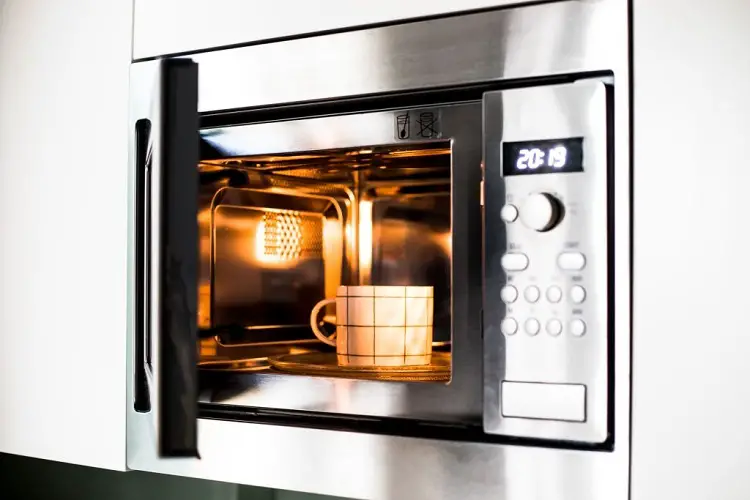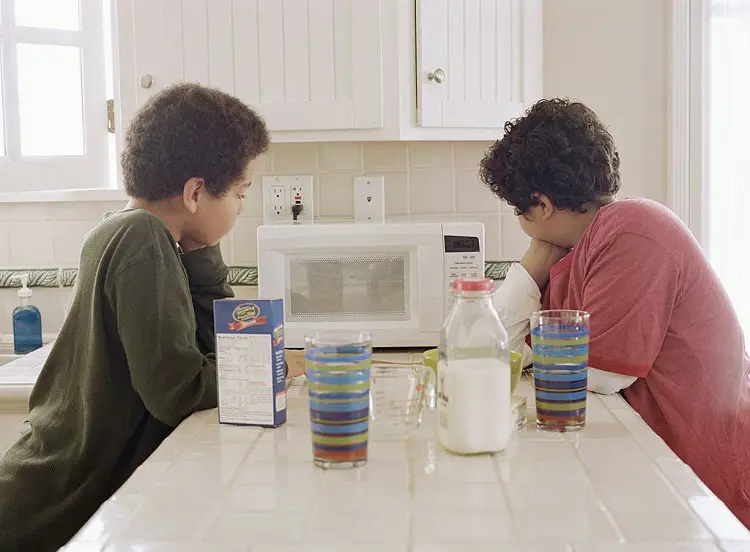Are you wondering why your milk curdles when heated in the microwave? You notice that each you warm a cup of milk in the microwave, after some time you notice some sticky substance on the milk which usually ruins the texture and appearance.
You begin to wonder if you did something wrong or whether the milk has gone bad. Well, several factors can cause your milk to curdle as it cooks, but most can be avoided.
If you’re concerned about this, don’t worry, we have the answer to your question in this post. We hope the answer provided in this article will help you to prevent it from happening again read on.
How Curdling Works
From a scientific point of view, milk isn’t a single substance. It comprises a complex mixture of dissimilar ingredients, bound in a reasonably stable suspension.
Most of the milk volume comprises water, but it also includes large quantities of other minerals, fat, sugars, casein proteins, and whey proteins.
When viewed under a microscope, the casein proteins look similar to tiny pompoms with a large number of thin tendrils sticking out on all sides.
Normally, they have an electrical charge which helps them repel one another. But if an external factor alters that charge, they grip together and form larger masses or curds.
Milk Curdles When Heated In The Microwave

When you heat milk, the protein molecules on the surface start to coagulate. The reason why your milk curdles when heated in the microwave is that your microwave temperature is too high and boils your milk too rapidly.
Your microwave does not heat your food evenly hence it boils your milk too fast. It is not recommended to boil milk too rapidly. When this happens it causes the casein in the milk to clump together and that curdles the milk.
Rather it is recommended to boil the milk by heating on a slow heat for a long period until it starts to boil. Alternatively, you can try other options like:
- You can pour the milk into a pan while allowing it to boil on a stove on slow heat. Doing this may take some time depending on the amount of milk poured. This method is quite effective, just make sure your pan is clean and the heat is low. I can assure you you’ll get a successful result.
- Another method is to pour the milk into a microwave-safe container then microwave the milk at 70% temperature (medium-low) for around 30-60 seconds. Then every 15 seconds stir the milk until steam begins to rise from the milk. Stirring the milk will avoid scorching at the bottom and also prevent the skin from forming sugars and proteins at the top of the milk. To scald milk for your custards or yogurt, you should heat 1 cup on high heat for 2-3 minutes.
Hint:
The timing mentioned here is by no means absolute because this will depend on the quantity of milk you’re using and the type of microwave you have.
Always remember that no microwave is created equal; some have higher watts of power while others have lower or average watts of power.
If you want to prepare the perfect hot or warm milk for your baby, we recommend you test the timing yourself to find out which gives the perfect milk that is up to your taste and warmth.
Read Also: What Happens If Baby Drinks Spoiled Breast Milk
What Are Microwave-Safe Containers?
These are containers or items made up of materials that can be utilized inside the microwave oven safely without the heat destroying it or igniting the fire.
Additionally, non-microwave-safe containers are containers or items that are made up of materials that may ignite a fire, melt, or cause arcing.
Below are the lists of materials that can or cannot be microwaved.
Materials you can use in a microwave oven:
- Heat-resistant oven glassware
- Most paper plates and cups
- Plastic (only those that are labeled “Microwave Safe”)
- Paper towels
- Ceramics
- Wax and parchment paper
- Oven cooking bags
Materials You Shouldn’t Use in the microwave oven:
- Aluminum tray
- Food carton with metal handle
- Paper bags
- Plastic foam
- Wood
- Metal or metal-trimmed utensils
- Metal twist ties
Related Posts:
- Why Your Milk Turn Yellow When Frozen
- Why Your Thawed Breast Milk Looks Grainy
- How To Clean Dried Milk From Coffee Machine
- 16 Best Cocoa Powder For Hot Chocolate
- How Long To Microwave Milk For Hot Chocolate
Conclusion
We hope this article has given in-depth discussion to answer your question of why my milk curdles when heated in the microwave.
As we all know, microwaving foods and drinks has proven to be the fastest and easiest way to heat food without you needing to be in your kitchen.
But when it comes to microwaving milk, it’s an entirely different thing, proper care and guidelines must be followed.
If you notice your microwave often gives your milk an unpleasant look by curdling, don’t panic it’s likely your milk hasn’t gone bad. Just follow the guideline listed above, you’ll be fine.
You can also try using the traditional way of heating milk by simply boiling your milk in a deep pot over a stovetop. This method is safer and easier too!
